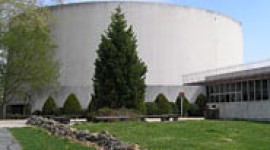Litmus Tests and Historic Preservation
With the expected announcement of a new Supreme Court nominee, the phrase Litmus Test will get a healthy airing. Rulings and opinions about abortion, gun control and other issues are each a “litmus test” for a nominee’s qualification to sit on the bench.
In thinking about this, I began to wonder if there should be a "litmus test" by which we judge future leaders in historic preservation and design, perhaps one that embraces multiple values? Take the proposed demolition of Richard Neutra's Cyclorama, his 1961 Lincoln Memorial at Gettysburg. This decade+ long controversy raises issues of planning, historic preservation and modernism. I would like to know what the candidates to replace Richard Moe, who is retiring next month as president of the National Trust for Historic Preservation, have to say; and, wouldn't it have been helpful to hear what the frontrunners for director of the National Park Service had in mind, before the new director, Jon Jarvis, was named. Perhaps we can invite the candidates to a panel discussion at the National Building Museum and open the floor to questions? For example, are any of those under consideration for the top post at the Trust historians of Civil War battles? Did they grow up in a Modern house in a postwar suburb?
The reason that I am asking this question (just one day after the Cape Wind decision was announced), is because of U.S. District Judge Thomas F. Hogan's recent ruling about the Cyclorama. According to the Philadelphia Inquirer, on April 5 Judge Hogan, in the case Recent Past Preservation Network, et al. vs. Superintendent John Latschar, ruled in favor of a diverse community of designers, historians and preservationists which led the National Park Service to agree to delay demolition until the lawsuit is resolved.
So what does this mean? Well, we know more about the issues involved than when the lawsuit was first filed. The controversy has stimulated a tremendous amount of research and scholarship. In addition, the National Trust now has a national initiative addressing Modernism and the Recent Past. And, in a significant recent development, celebrated landscape architect Lawrence Halprin's modernist work in Springfield, Missouri, built a decade after the Cyclorama, was honored with designation on the National Register of Historic Places.
With this fertile ground for informed discourse, and a broadening of values playing out nationally, what are the questions that should be asked of future leaders in historic preservation and design? Let's have a debate.




